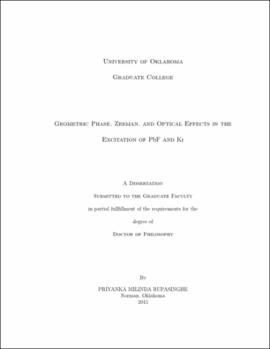| dc.contributor.advisor | Shafer-Ray, Neil E | |
| dc.creator | Rupasinghe, Priyanka Milinda | |
| dc.date.accessioned | 2019-04-27T21:34:14Z | |
| dc.date.available | 2019-04-27T21:34:14Z | |
| dc.date.issued | 2011 | |
| dc.identifier | 99306015202042 | |
| dc.identifier.uri | https://hdl.handle.net/11244/319041 | |
| dc.description.abstract | This dissertation is motivated by two major challenges in modern Physics. One is related to precession measurement and other is related to atmospheric science. | |
| dc.description.abstract | The amount of CP violation (equivalently time reversal (T) symmetry violation) that occurs in the Standard Model, the most successful theory in the particle physics today, is not sufficient to explain why we live in a matter (rather than anti-matter) dominated universe. A measurable electric dipole moment of the electron (e-EDM) proportional to its spin may help to unravel this matter anti-matter mystery and could point the way to physics beyond the Standard Model. | |
| dc.description.abstract | As an e-EDM probe, both cold molecular trap and molecular beam techniques have been proposed. In this thesis we show that the geometric phase effect limits the viability of a cold molecular trap technique. Specically we show the molecular trap method can not be employed for PbF until the technology is available to cool down | |
| dc.description.abstract | molecules to ultra cold temperatures. | |
| dc.description.abstract | This thesis also addresses two major difficulties that need to be overcome in order to carry out a molecular beam e-EDM measurement. One of these difficulties is that background magnetic fields mimic the e-EDM. For this reason, molecules with small magnetic g-factors greatly reduce the background due to this effect. In this dissertation investigation of the Zeeman structure of the PbF molecule including state dependent g-factor measurements are determined through extensive analysis of | |
| dc.description.abstract | microwave spectroscopy. | |
| dc.description.abstract | The other major difficulty addressed in this thesis is the requirement to create a highly uniform electric field that can be reversed in a precise and consistent manner. Specifically we describe a precise high voltage control and switching system that has been built. | |
| dc.description.abstract | Isotopic detection of Krypton has many important applications including archaeological dating beyond that possible using ^{14}C and nuclear activity monitoring all around the world. It has been shown that laser cooling and trapping of metastable Kr (5s[3/2]_{2}) is an effective means to achieve detection efficiencies of 1 part in 10^{12}. A limiting factor in these studies is the production of metastable Kr, which is currently implemented using an RF discharge. In this dissertation, an attempt at laser-based excitation is described which may be useful to increase these detection efficiencies by many orders of magnitude. | |
| dc.format.extent | 89 pages | |
| dc.format.medium | application.pdf | |
| dc.language | en_US | |
| dc.relation.requires | Adobe Acrobat Reader | |
| dc.subject | CP violation (Nuclear physics) | |
| dc.subject | Dipole moments | |
| dc.subject | Time reversal | |
| dc.subject | Microwave spectroscopy | |
| dc.title | Geometric Phase, Zeeman, and Optical Effects in the Excitation of PbF and Kr | |
| dc.type | text | |
| dc.type | document | |
| dc.thesis.degree | Ph.D. | |
| ou.group | College of Arts and Sciences::Homer L. Dodge Department of Physics and Astronomy | |
